Fingerpicking Notes
Russell Bateman
September 2020
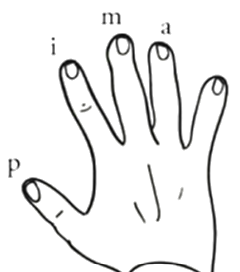
Fingerpicking notes from a class by Mike Baelde at Guitar Mastery Method. The
details in these notes concern modern styles of guitar playing like folk, rock
and western—not classical. Nothing here pretends to tackle
classical-guitar playing or techniques.
Finger designations
In italics, the formal designation. Because guitar playing has such
strong roots in Spain, terminology is Spanish though there are equivalents in
other languages.
- pulgar, thumb (from Latin, pollux)
- indice, index finger
- medio, middle finger
- annular, ring finger
- chico, pinky finger
Typically, the pinky is not used to pluck strings, but serves to touch the
guitar body. While it's possible to perform Travis picking leaving your ring
finger to join the pinky in support of the other other fingers. However, this
wastes the ring finger given that you might find the better use for it of
controlling the E string. You only have the thumb and three fingers, yet six
strings to control (4/6). Why waste yet another finger when the pinky is
enough, in contact with the pickguard or guitar body near the f-hole, to
stabilize and impart precision. You can dedicate the pinky to the E string to
lower the ration even further, as is done in classical guitar, however, putting
the pinky down to anchor the position of your hand gives you advantages nearly
for free without requiring the development of much technique.
I originally put down both the ring and pinky when I was young. When I started
guitar back up recently (after a 40-year absence), I got over this. Of course,
when I was young, there was no money for guitar lessons. Since that time, there
has also appeared the almighty Internet.
Tablature
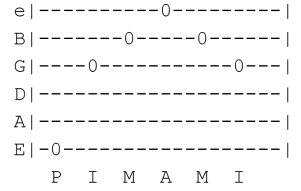
The tablature describing picking procedures and patterns is confusing because
it must carry chords, strings, frets, sequence and time or beat. It looks like
a fretboard, but vertical marks look like frets when, in the system described
here, they denote beats (or time).
Here is a very basic tablature to begin fingerpicking training. It suggests
that you pick all open strings (what the 0 means). The finger to use
is indicated across the bottom of the tablature and, as the tablature proceeds
from left to right, the string to be picked is represented by 0.
Thus, you dedicate your thumb to the large E string nearest you at the top of
the guitar, and your index, middle and ring fingers to the bottom three
strings, those farthest away from you): G, B and e.
The sequence is very harp-like: thumb, then index, middle and ring, then
reverse, ring, middle and index, and, finally (but not shown here), the thumb
again which starts you off repeating the pattern.
Picking styles
There are myriad styles of guitar fingerpicking including those of classical
guitarists like formal classical, flamenco and, to some extent,
bossa nova.
In North America, with the evolution of Scotch-Irish music and the substantial
contributions of African influences over 200 years, there have been identified
in particular:
- country blues
- American primitive
- country music
- ragtime
- Carter-family picking
- Travis picking
- clawhammer and frailing (primary banjo techniques)
- percussive
- funky
- African
- slide guitar
- slack-key guitar
- fingerstyle jazz (including Mark Knopfler)
- electric blues and rock
Travis picking
(Merle Travis, 1917-1984)
Travis picking is one of the most common styles employed by folk and folk rock
guitar playing—everything from Merle Travis (himself, obviously) to the
Everly Brothers, Peter, Paul and Mary, Gordon Lightfoot (think In the Early
Morning Rain), much of Jim Croce and even Lindsay Buckingham
accompanying Stevie Nicks singing Landslide and Kansas singing Dust
in the Wind.
Travis picking is characterized by using the thumb to pick a bass line while
the other fingers bring out melody and chording especially in syncopated
melodies.
The most succinct tablature representation of Travis picking—and it uses
only the thumb, index and middle finger, is this:
middle │ • • - │ • • - │
index │ • • - │ • • - │
thumb │ • • • • - │ • • • • - │
──────────────────────────────────────────────────────────────────
beat 1 & 2 & 3 & 4 & 1 & 2 & 3 & 4 &
Note that:
- The thumb alternates between base notes (i.e.: the bottom note of whatever
chord is being played; this will be the E, A or D strings depending on
the chord),
- The index and middle pluck the more treble notes of the chord played on
the G, B and e strings.
- Note that, where two strings are to be plucked on the same beat, these are
in essence "pinched"—always the thumb and one of the fingers.
- Care must be taken not to pluck strings that don't contribute to the chord;
typically, this is more often a problem for the thumb and determines
which bass note it will pluck.
A different representation...
This is the one taught me by Mike Baelde. Notice that on every even beat, the
thumb is plucking a bass string. Note also that the ring finger is doing
nothing.
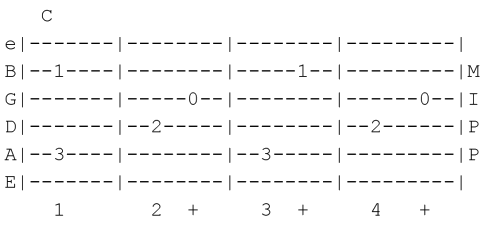
1 means pinch A and B strings with thumb (bass) and middle finger
1& (nothing)
2 means pluck D string with thumb (bass)
2& means pluck G string with index finger
3 means pluck A string with thumb (bass)
3& means pluck B string with middle finger
4 means pluck D string with thumb (bass)
4& means pluck G string with index finger
Let's continue this "song" by changing the chord from C to G:
// TODO: fix these next two lists.
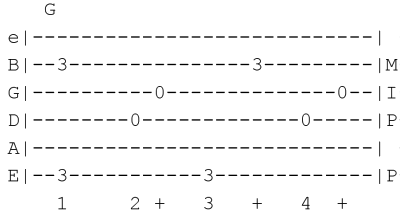
-
1 means pinch A and B strings with thumb (bass) and middle finger
1& (nothing)
2 means pluck D string with thumb (bass)
2& means pluck G string with index finger
3 means pluck A string with thumb (bass)
3& means pluck B string with middle finger
4 means pluck D string with thumb (bass)
4& means pluck G string with index finger
...then to the D chord:
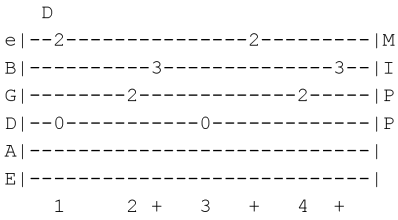
-
1 means pinch A and B strings with thumb (bass) and middle finger
1& (nothing)
2 means pluck D string with thumb (bass)
2& means pluck G string with index finger
3 means pluck A string with thumb (bass)
3& means pluck B string with middle finger
4 means pluck D string with thumb (bass)
4& means pluck G string with index finger




